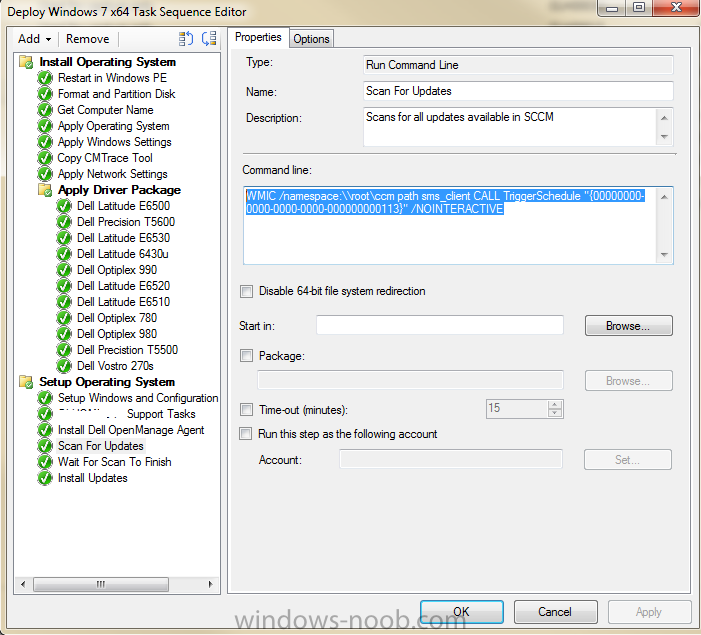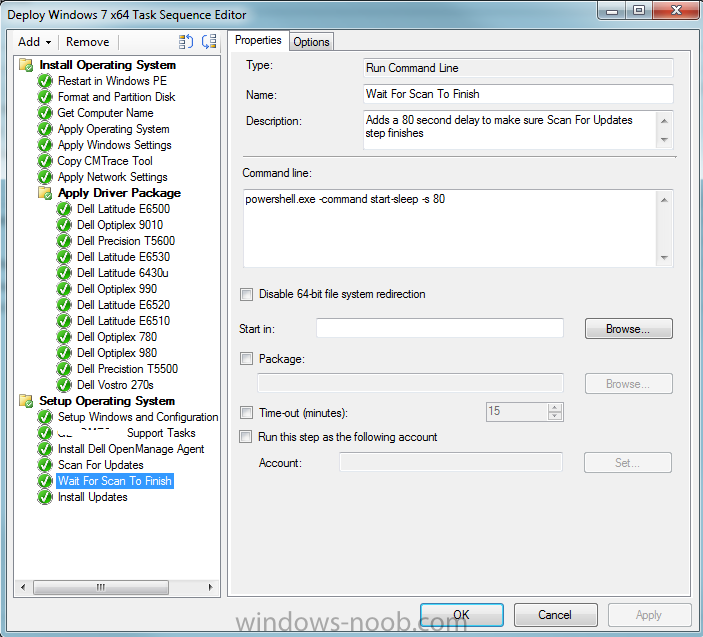
n00blar
Established Members-
Posts
74 -
Joined
-
Last visited
-
Days Won
2
Everything posted by n00blar
-
Sorry to resurrect this thread, but I have the exact same issue and I'm still unable to change cache size from within a task sequence. I know I can do it as a package, an app, etc, etc, but I want to do it as part of a task sequence. I even read a MS Blog that says that it's supposed to work using SMSCACHESIZE=10240 in Setup Windows and ConfigMgr section, but it just doesn't work. Has anyone been able to get this to work from a task sequence? Thanks!!
-
Deploy Windows 2008 R2 using SCCM 2012 SP1
n00blar replied to n00blar's topic in Configuration Manager 2012
Great! I think I'll use MDT in this case.- 2 replies
-
- windows 2008 R2
- OSD
-
(and 2 more)
Tagged with:
-
I was wondering if anyone had a link that explains how to deploy Windows 2008 R2 Server using SCCM 2012 SP1. I'd like to be able to install certain Windows 2008 R2 roles (file sharing, printing, dfs, etc) and features (branchcache, snmp, etc) with SCCM 2012. I've looked around, but mainly I find Windows 7 deployment. Thanks!
- 2 replies
-
- windows 2008 R2
- OSD
-
(and 2 more)
Tagged with:
-
Install Windows Updates Using Task Sequence
n00blar replied to n00blar's topic in Configuration Manager 2012
Yes, I did...and nothing.- 4 replies
-
- updates
- task sequence
-
(and 2 more)
Tagged with:
-
I'm running SCCM 2012 SP1 and here's what I'm trying to achieve. I'm trying to deploy Windows 7 x64 SP1 updates via the same task sequence that deploys the OS. What I've done: Task sequence works and it targets the All Unknown Computers device collection Created a Scan For Updates task Created a Wait For Scan To Finish task Created Install Updates task Created a Software Update Group that lists Windows 7 x-64 updates for the last 9 months Created a deployment task for step 5 that targets All Unknown Computers device collection Created a Deployment Package for step 5 Here's what happens: OS is deployed properly Updates don't seem to be installed Here are some warnings I read in the WUAHandler.log file: Unable to read existing WUA resultant policy. Error = 0x80070002. Seems Group Policy is not yet initialized because client is in provisioning mode, writing WSUS Server location in registry. Here are errors in the smsts.log file: (these seem to be new errors that come up after installing SP1, but I don't know if these are preventing the updates from installing) CryptProtectData failed TSManager 5/8/2013 12:06:55 PM 2828 (0x0B0C) DecryptString failed. 8007000d. TSManager 5/8/2013 12:06:55 PM 2828 (0x0B0C) CryptProtectData failed TSManager 5/8/2013 12:06:55 PM 2828 (0x0B0C) DecryptString failed. 80070057. TSManager 5/8/2013 12:06:55 PM 2828 (0x0B0C) Getting active request access handle TSManager 5/8/2013 12:06:55 PM 2828 (0x0B0C) Error opening HKEY_LOCAL_MACHINE\Software\Microsoft\SMS\Task Sequence. code 80070002 TSManager 5/8/2013 12:06:55 PM 2828 (0x0B0C) Error - could not get package and program IDs. code 80070002 TSManager 5/8/2013 12:06:55 PM 2828 (0x0B0C) Failed to open the task sequence key HKLM\Software\Microsoft\SMS\Task Sequence. Error code 0x80070002 TSManager 5/8/2013 12:06:56 PM 2828 (0x0B0C) I'm attaching some of the configuration settings I've created in the task sequence.
- 4 replies
-
- updates
- task sequence
-
(and 2 more)
Tagged with:
-
Not just another "how do I prompt for computer name" thread ;)
n00blar replied to h4x0r's topic in Configuration Manager 2012
I've also modified it to extract DELL's asset bios label, and I use that information for SCCM's variable. -
SCCM2012 Automatic Computername in OSD^
n00blar replied to easybernd's topic in Configuration Manager 2012
At my company I use DELL's asset label (not the asset tag) for the computer's account name in active directory. We set the asset label during our BIOS setup, and then my script extracts this value and assigns it to the SCCM variable for the computer name. If there is no asset label configure in BIOS, the entire process stops. -
Not just another "how do I prompt for computer name" thread ;)
n00blar replied to h4x0r's topic in Configuration Manager 2012
I did something like that in my environment, check out this link with what I did. -
Automatic User and Device Affinity Guide
n00blar replied to hypercube33's topic in Configuration Manager 2012
Question, what's the purpose for enabling audits for login events? How does that match with UDA? Just curious. -
Did you Update Distribution Points? Sounds like to made quite a few changes, try removing the drivers you loaded to the Boot Images and see if that works again. Another thing you can try is, go to the properties of the boot image, then go to Images tab and use Reload. This may help, but I'm not sure. I also have DELL machines, and I used DELL WinPE drivers, but I didn't use WAIK or any other application. I did it all via SCCM console with no issues.
-
On the client that fails during Win PE boot, try pressing F8 to open a command line. Then from the command line, make sure that you can access your network, also, try to copy the client log file to review it.
-
Silent install
n00blar replied to mr_sherief's question in Deploy software, applications and drivers
Sherief, This link will help you with Office 2010. Adobe is quite simple, go to ftp://ftp.adobe.com and download the MSIs for reader there; the same goes for flash. -
Great article. Question, what's the recommended way of creating an OS image? Is it this one (create an image with all business-like applications) or the one specified in Part 7 of the SCCM 2012 labs? If I use the captured image (Part 7 lab), I can install all my packaged applications as an OSD task. Later on, if need be, I can upgrade those deployed packaged applications. I'm wondering if I can, safely, upgrade applications that have been installed in the captured-media image?
-
Well, not exactly. Site name and server name are different, same goes for ip information, etc.
-
Question, so during my RC1 and RC2 labs I created a captured WIM file and I was wondering if I could copy that file (from my lab) and import it into my production SCCM server. Will this be viable option or is it better to start fresh?
-
I believe so; after getting my test devices properly provisioned, WoL worked properly.
-
You can do it with an internal PKI, but you'll have to manually add those certificates to each machine. I had a big issue with this on RC1 and RC2 labs. I opened a case with MS, and I had some of the chinese team that works on AMT work with me. Basically, you want to purchase an AMT certificate from GoDaddy and use it (this is a special certificate, it's about $300.00. It's called an Intel vPro certificate). Once I purchased the cert, I was able to properly provision the machines in my lab. However, I had issues with the AMT console; the MS team built a new console for me which never worked. They even had a meeting with Intel on how to make it work and it never worked for me. I'm just hoping they fixed this bug. I hope this helps.
-
I believe you can, very few things changed since RC2, so anyweb's guides are still valid.
-
That is a bit of work just to keep a server name. Personally, I would just start fresh from start if I was so caught up in keeping server naming convention. Also, due to the fact that you'll be doing a 2012 to 2012 migration; I would place a call to MS, just to be on the safe side, and maybe get some feedback from them. I've never done a 2012 to 2012 migration on any of my labs, so I wouldn't be able to give you any good feedback. As stated, the move seems fine, but what about schema information, and GUIDs if applicable, that may change once you start making those changes? Again, I would place a call to MS just to be safe.
-
Preparing a SCCM 2012 Installation Hierarchy - advice
n00blar replied to n00blar's topic in Configuration Manager 2012
Oh, I definitely missed that document. Thanks for pointing that out. -
Preparing a SCCM 2012 Installation Hierarchy - advice
n00blar replied to n00blar's topic in Configuration Manager 2012
Thanks Anyweb. Good thing you mention that Endpoint Protection must be on the CAS. I've downloaded some MS docs and they don't mention anything at all about that. However, I wasn't planning on doing a CAS deployment though, just a Primary site with a Deployment point. Yeah, that's a SAN LUN. Allow me to explain about the 1TB storage. I was planning on a single drive VM with a very large virtual disk. What are your thoughts about that? -
As SCCM 2012 is set to come out soon, we're in research mode for SCCM 2012 hierarchy installation. Our environment is as follows: All Windows OS Shop Clients: Run Windows XP, and will be upgraded to Windows 7 x64 Enterprise within 3 months Servers: Active Directory Windows 2008 R2 mode User count: 260 desktops (~30 laptops) Server count: ~60 (almost all of them are virtual running on VMWare ESX 4) Servers are located at our datacenter (spoke) and about twelve remote offices, this includes corporate ~90 users, (hubs). Based on our device/user count we've come up with two installation designs, and I'd like to hear your comments on both. 1. Single server installation - opting to move some system roles base on performance (if needed). 6 vCPUs - 64 GB Ram - ~1 TB storage Note: In the event that we notice poor performance, we intend to move some roles off this server (we would probably move DP, SUP, EPP and the SQL installation). I'd like to hear some comments about this approach. 2. Three server installation - a database server, a DP role server (SUP and EPP) and a primary site. Primary site server: 4 vCPU - 16 GB Ram SQL Server: 6 vCPU - 32 GB Ram Distribution Point: 4 vCPU - 16 GB Ram - additional storage I'd like to hear some comments on both approach, thanks for your time.
-
I'll check on this and see if it makes any difference; however, in my case, I've deployed the TS to all 'unknown' devices.
-
I've actually opened a case at MS Connect, you can find it here. (you may need to login to read these forums). No answer yet, we're still going through troubleshooting.



